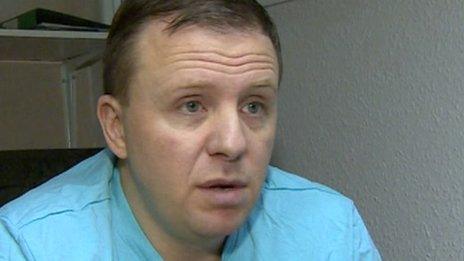Social housing: Essex has thousands on waiting lists
- Published

Jay Brown has slept on a friend's sofa for two years
About 8,000 people have been on social housing lists in Essex for more than five years, it has emerged.
In one case, a person in Thurrock has been on the waiting list for 57 years.
Responding to a BBC survey, the district, borough and city councils in Essex said they were working on different ways to cut the waiting list.
Several authorities, including Harlow, Epping Forest and Tendring, are planning to build their first council homes in a generation.
Jay Brown, 39, has been on the housing list in Harlow for more than two years, after his pub business went under and he lost his home.
Mr Brown, who works for a marketing company, considered sleeping in his car, but a friend offered him a place to stay.
Harlow Council placed him on the second-bottom tier of its waiting list, meaning he was considered to have a low level of need.
"The system doesn't work. I've been asking for help for the last couple of years, and people have been asking for a lot longer than me, and you just keep getting knocked back".
The father of five says his housing situation has had a major impact on his life.
'Going backwards'
"Without my own space and my own independence, all I'm going to do is keep going backwards. It's affected my job. It's affecting relationships with my children and friends. It just puts a strain on everything."
A Harlow Council spokesman says it receives 130 applications for housing every month, and there are far more people wanting homes than the authority can accommodate.
Its situation is far from unique. Data compiled by the BBC shows there are more than 100,930 social homes in Essex, but there are almost half again, 47,233 people, on housing waiting lists. Around 7,880 have been waiting more than five years.
Councils allocate housing on the basis of need, with those considered to have low priority potentially waiting a very long time to get a property.
According to Paul Price, a director at the Association of Retained Council Housing, councils stopped building homes because of a system where the government kept much of the rent it raised.
"The large building that went on in the 1960s, 1970s and 1980s just stopped because of the perverse subsidy system".
But Mr Price, who is also the corporate director of Tendring District Council, says this in itself doesn't explain why supply of housing is outstripped by demand.
"We've got more single or smaller house-holds, so larger numbers of people wanting housing. You see a lot of people coming on to the waiting list who want social housing rather than need it."
A change in the rules allowing councils to keep more of the rent they raise from their own stock has meant some authorities are now building new council homes for the first time in a generation.

These new homes have recently opened in Thurrock
In December, Thurrock Council opened 16 flats in Corringham.
At the moment, there are 5,426 people on the social housing list in the borough.
The Labour leader of the council John Kent says even though it plans to build around 200 new homes every year for the next five years, that won't be enough to meet demand on its own.
"Clearly that won't meet the full need, so we need to work with our partners in housing associations to help bring forward other forms of social housing.
"We also need to work with developers as they develop private housing in the borough to get an element of that as social housing, or other forms of affordable housing. It's not a 'one size fits all' solution."
- Published16 April 2012
- Published19 October 2010